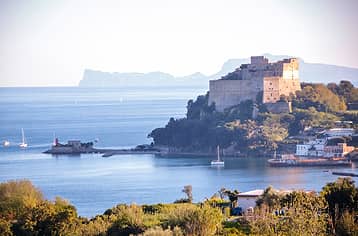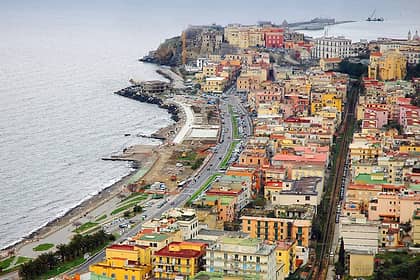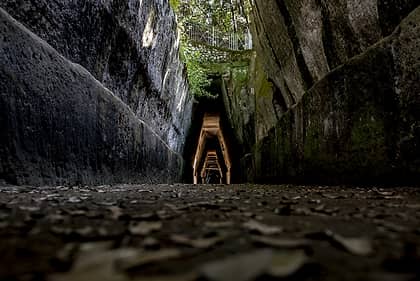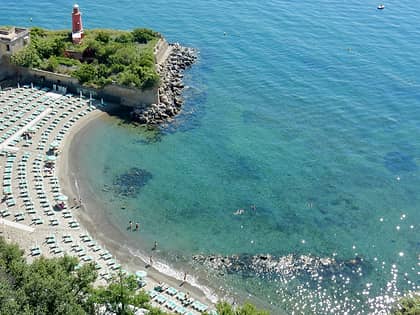The Phlegraean Fields

The Italian name Campi Flegrei can be translated as "The Fiery Fields", and it is a fitting moniker for this stretch of coastline west of Naples that lies above the the largest volcanic area in Europe. This fascinating area is home to a number of important archaeological sites, coastal lakes, beaches, thermal springs, and nature reserves and is worth a day trip from the bustling capital city of Campania.
The Best Time to Visit the Phlegraean Fields (Campi Flegrei)
The Best Time to Visit the Phlegraean Fields (Campi Flegrei)
If you are planning an excursion to the Phlegraean Fields, we suggest visiting in spring or autumn. In addition to avoiding the high-season crowds and prices, the mild weather in these shoulder seasons makes for a much more pleasant visit; remember that much of the Campi Flegrei are active thermal and volcanic areas, so can be uncomfortably hot in the summer months. In the winter, many restaurants and other businesses close for the season.

Getting to the Phlegraean Fields from Naples
Getting to the Phlegraean Fields from Naples
The Phlegraean Fields are only about 40 minutes from the center of Naples, and can be reached by public transportation via the Ferrovia Cumana rail line that departs from a number of stations in central Naples, including Montesanto in the historic center and Corso Vittorio Emanuele in the Mergellina and Fuorigrotta neighborhoods. The Cumana stops in a number of locations in the Flegreaen area, including Agnano, Pozzuoli, Lucrino, and Lake Fusaro.
You can also take metro line 2 that runs between Agnano and Pozzuoli.
The Phlegraean Fields by Car
It's easy and convenient to take in the top sights in the Phlegraean Fields by car, especially if you are visiting outside of the crowded high season. In summer, we do not suggest trying to get around by car on the weekends, as traffic can be very heavy. Keep in mind that you must also buy a pass and pay for parking to access the most popular beaches in the Phlegraean area in the summer months.
What to See in the Phlegreaen Fields
What to See in the Phlegreaen Fields
The Phlegraean area is rich in historic, cultural, and natural sights and you will need at least two or three days to admire them all; we suggest booking a hotel in the area to avoid wasting time on transportation.
Depending upon the amount of time you have and what your interests are, you can decide to pick and choose the sights to visit, even limiting your time to a day trip or half-day excursion.
Pozzuoli
Pozzuoli is the most important town in the Campi Flegrei, well-connected to Naples and located just 20 kilometers from the city center. This pretty seaside town has ancient roots and is set along the gulf of the same name.

In Pozzuoli, you can visit a number of ancient Greco-Roman sites, including the Flavian Amphitheater (the fourth largest in Italy) and the Temple of Serapis, an ancient Roman open-air market.
A Trip to Inferno
If you are planning on visiting Pozzuoli, be sure to stop at the Averno Lake, a small lake set inside an extinct volcano located between the towns of Cuma and Lucrino near the coast. Lined by a number of archaeological sites, the lake is famous for being named by the Roman poet Virgil as the entrance to hell in his epic Latin poem "The Aeneid".
You can also visit the Oracle of the Cumaean Sibyl , the priestess that presided over the Apollonian oracle at Cumae, an ancient Greek colony that was once located in the Phlegreaen Fields. The cave where the sibyl pronounced her prophesies is known as the Antro della Sibilla, and is located in the modern city of Pozzuoli where Cumae once stood.
The Pozzuoli port is a popular and convenient jumping off spot to visit the islands of Ischia and Procida.
Baia
The town of Baia, part of the larger municipality of Bacoli, is another must-see in the Campi Flegrei due to its ancient treasures. Don't miss the Piscina Mirabilis, an impressively immense Roman cistern, and the Castello Aragonese set in a strategic spot overlooking the sea and home to an interesting archaeological museum. Near Baia's castle, you can also relax on the small beach to break up your day of touring.

Visiting Baia's Castello Aragonese
Address: Via Castello 39, Bacoli (Naples)
Hours: 9AM to 2:30PM, last entrance at 1:30PM. Closed Mondays.
Admission: EUR 4
Another highlight of Baia and the entire Phlegraean Fields is the Underwater Archaeological Park, home to the remains of the ancient city of Baia. Admire statuary, amphorae, remains of buildings, and other ancient artifacts hidden beneath the waters of the Mediterranean.
A Glass-Bottomed Boat
To take in the treasures of the Underwater City of Baia, join a guided tour on board a boat with a transparent bottom that provides a unique window into the underwater ruins and a chance to travel backwards in time. If you are a diver or snorkeler, you can explore the ruins up close by taking a diving excursion into the ruins, one of the most unique experiences in the Phlegraean Fields.
Lake Fusaro
Near the town of Baia outside Bacoli, stop to visit Lago Fusaro, a coastal lake mentioned in "The Count of Montecristo" by Alexandre Dumas. In the center of Lake Fusaro and connected to the shore via a wooden bridge, the 18th-century Casina Vanvitelliana hunting lodge was designed by the famed architect Vanvitelli for the Bourbon King Ferdinando IV .

The Cratere degli Astroni Nature Reserve
If you love hiking and outdoor sports, the Phlegraean Fields is ideal for experiencing the great outdoors on foot. Visit the WWF Cratere degli Astroni Nature Reserve that covers roughly 250 hectares, including three lakes and a number of forested hills, to take in the variety of native flora and fauna; the reserve offers guided tours that must be booked in advance.
Visiting the Cratere degli Astroni Nature Reserve
Address: Via Agnano Astroni 468, Naples
Winter Hours: 10AM to 5PM; last entrance 3PM
Summer hours: 10AM to 6PM; last entrance 4PM
Admission: EUR 6
Beaches in the Phlegreaen Fields
Beaches in the Phlegreaen Fields
The Phlegreaen Fields are the perfect destination for those who want to pair cultural sites with a stop at the beach. Most of the beaches in this area are volcanic, with dark sand or pebbles. Their volcanic nature also means that the water is not always crystalline, especially in the crowded months of July and August. Be prepared for heavy traffic and long waits to enter the parking areas in the summer; we suggest avoiding visiting on the weekend.

The most beautiful beaches in the Phlegreaen Filds are Miliscola, the beach next to the Baia castle (accessible only by boat), and the Romana di Bacoli and Insenatura dello Schiacchetiello beaches, both in Bacoli.
A Private Island
For a unique day at the beach, visit the islet of San Martino, a tiny island that detached itself from Monte di Procida during an earthquake in 1488. The island is private property, but can be reached via the 3-kilometer toll tunnel from Cappella, halfway between Monte di Procida and Bacoli.
Most of the coastline in the Phlegreaen Fields has both free, public beaches and private beach clubs which rent sun beds and umbrellas by the day.
Visiting the Hot Springs in the Phlegreaen Fields
Visiting the Hot Springs in the Phlegreaen Fields
Due to their volcanic origins, the Campi Flegrei are rich with thermal springs where locals and visitors alike have gathered to soak in the therapeutic waters for hundreds of years.

If you love hot springs, we suggest that you set aside at least a few hours to relax in the thermal baths located in the Phlegreaen Fields. The Stufe di Nerone in Baia are located on the spot where ancient Romans once gathered to "take the waters" and include pools and baths in a variety of temperatures, thermal mud baths, and two natural saunas located inside small grottoes where the temperature reaches 53°C. The spa here also offers a restaurant and a variety of therapeutic massages.
Alternatively, visit the historic Terme di Agnano which offers a variety of thermal pools and a spa with massages and treatments.